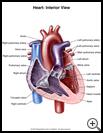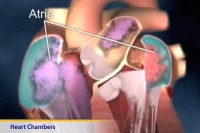
Congenital Heart Disease
What is congenital heart disease?
Congenital heart disease is a heart problem that a child is born with. It means that the heart did not develop normally before birth.
Three kinds of problems can be caused by congenital heart disease or defects:
- The heart does not pump blood well because it is not fully developed.
- Blood flow in the heart is blocked by abnormal heart valves or arteries. This can put a strain on the heart muscle.
- The path of blood flow through the heart or major blood vessels is not normal.
An abnormal path of blood flow usually happens when there is a hole in the walls of the heart. Sometimes there is an abnormal connection between 2 arteries outside the heart. In some cases, blood that should be flowing to the lungs for more oxygen flows instead to the rest of the body. In other cases, blood that should go to the rest of the body may go to the lungs. Sometimes the heart rhythm (heartbeat) is not normal.
Mild congenital heart defects may not be noticed until adulthood.
How does it occur?
Most of the time the cause of congenital heart disease is not known.
Some conditions that increase the risk of being born with a heart defect include:
- Other family members have congenital heart disease.
- The mother has diabetes.
- The mother has an infection during pregnancy, such as rubella (German measles).
Some medicines or drugs taken by the mother during pregnancy or even a month or 2 before pregnancy may increase the risk that a baby will be born with a heart defect.
What are the symptoms?
If the defect is mild, there may be no symptoms. Most defects, however, cause a whispering sound, or murmur, as blood moves through the heart. Healthcare providers can hear the murmur with a stethoscope.
Symptoms a heart defect may cause include shortness of breath, chest pain, or skin or lips that look blue (cyanosis).
How is it diagnosed?
Your child’s healthcare provider will ask about your child’s medical history and do an exam.
Some of the tests that may be done are:
- echocardiogram, which uses sound waves to create pictures of the heart (an ultrasound scan)
- electrocardiogram (ECG or EKG), which is a recording of the electrical activity of the heart
- angiogram, which uses X-ray pictures of dye injected into a blood vessel to look inside the heart and blood vessels
- MRI (magnetic resonance imaging), which uses magnetism, radio waves, and a computer to make pictures of the heart and blood vessels
- cardiac computed tomography (CT), in which X-rays are taken at different angles and then combined by a computer for pictures of the heart and blood vessels
- oxygen monitor to see if the oxygen level in the blood is low.
How is it treated?
The defect may be small and not need treatment. Sometimes it will get better without treatment. If the congenital heart defect is serious, it may need repair. Depending on the type of defect, this may be done with heart catheterization or open heart surgery.
How long will the effects last?
Many people with congenital heart defects can live normal lives. Some may need to limit their activities and take medicines.
How can I take care of my child?
If your child has congenital heart disease and no symptoms, he or she should have regular checkups. Your child may need to have regular follow-up visits with a heart specialist.
Ask your healthcare provider if your child should take antibiotics to prevent infection before having dental work or procedures that involve the rectum, bladder, or vagina.
Last modified: 2011-06-13
Last reviewed: 2011-06-06


